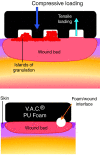Topical negative pressure therapy: mechanisms and indications
- PMID: 16722882
- PMCID: PMC7951556
- DOI: 10.1111/j.1742-4801.2004.00031.x
Topical negative pressure therapy: mechanisms and indications
Abstract
Topical negative pressure (TNP) therapy has emerged as a high-technology, microprocessor-controlled physical wound-healing modality. Complex effects at the wound-dressing interface following application of a controlled vacuum force have been documented. These include changes on a microscopic, molecular level and on a macroscopic, tissue level: interstitial fluid flow and exudate management, oedema reduction, effects on wound perfusion, protease profiles, growth factor and cytokine expression and cellular activity, all leading to enhanced granulation tissue formation and improved wound-healing parameters. Primary indications for clinical use have been documented and include traumatic wounds, open abdominal wounds, infected sternotomy wounds, wound bed preparation, complex diabetic wounds and skin-graft fixation. Whilst this therapy now forms an essential part of the wound healing armamentarium, extensive clinical trials are recommended to confirm efficacy and delineate its optimum use.
Figures






References
-
- Banwell PE. Topical negative pressure therapy in wound care. J Wound Care 1999;8(2):79–84. - PubMed
-
- Banwell PE, Teot L. Topical negative pressure (TNP): the evolution of a novel wound therapy. J Wound Care 2003;12(1):22–8. - PubMed
-
- Greer SE. Whither subatmospheric pressure therapy? Ann Plast Surg 2000;453: 332–4. - PubMed
-
- Fox JW IV, Golden GT. The use of drains in subcutaneous surgical procedures. Am J Surg 1976; 132(5):673–4. - PubMed
-
- Fay MF. Drainage systems: their role in wound healing. AORN J 1987;46(3):442–55. - PubMed
Publication types
MeSH terms
LinkOut - more resources
Full Text Sources
Other Literature Sources
Medical

